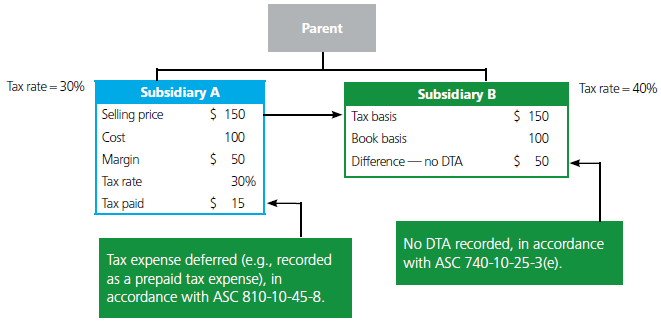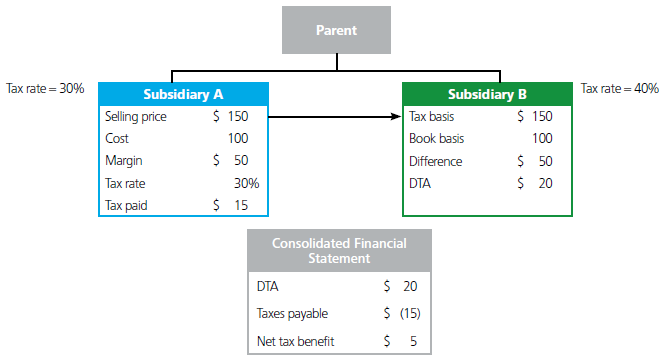Heads Up — FASB issues exposure draft on simplified accounting for income taxes
by Erica Czajkowski, Robert Morris, and Karen Wiltsie, Deloitte & Touche LLP
On January 22, 2015, the FASB issued an exposure draft (ED) of two proposed ASUs1 in an effort to simplify the accounting for income taxes. Under the proposed guidance, (1) entities would no longer defer the income tax consequences of intra-entity asset transfers until the assets are ultimately sold to an outside party and (2) all deferred taxes would be classified as noncurrent assets or noncurrent liabilities. Comments on the ED are due by May 29, 2015.
This Heads Up provides background on the proposed ASUs and summarizes their key provisions.
Background
The FASB’s project on the tax effects of intra-entity asset transfers and the balance sheet classification of deferred taxes is part of the Board’s simplification initiative, which focuses on projects that are narrow in scope and involve limited changes to guidance that can be made quickly. Launched in June 2014, the simplification initiative is intended to reduce the cost and complexity of current U.S. GAAP while maintaining or enhancing the usefulness of the related financial statement information.
Intra-Entity Asset Transfers
Under existing guidance, ASC 740-10-25-32 prohibits an entity from recognizing current and deferred income tax consequences of an intra-entity asset transfer until the entity sells the asset(s) to an outside party. The proposed ASU on intra-entity asset transfers would eliminate this prohibition and would require recognition of the income tax consequences upon transfer.
Balance Sheet Classification of Deferred Taxes
Currently, ASC 740-10-45-4 requires an entity that presents a classified balance sheet to separate deferred tax assets (DTAs) and deferred tax liabilities (DTLs) into current and noncurrent amounts in the financial statements. Under the proposed ASU on the balance sheet classification of deferred taxes, an entity would be required to classify all DTAs and DTLs as noncurrent.
Key Provisions of the Proposed ASUs
Intra-Entity Asset Transfers
As noted above, the proposed ASU on intra-entity asset transfers would eliminate the requirement to defer the income tax consequences of such transfers until the assets are ultimately sold to an outside party and accordingly would provide for the recognition of those tax consequences in tax expense when the transfers occur.
|
Editor’s Note: Although the current prohibition in ASC 740 against recognizing the income tax consequences of intra-entity asset transfers at the time of transfer is consistent with the requirement in ASC 810 to defer all income statement consequences of an intra-entity transaction, it is an exception to the principle of comprehensive recognition of current and deferred income taxes under U.S. GAAP. Further, the prohibition conflicts with IAS 12,3 under which the tax consequences of an intra-entity asset transfer are recognized in tax expense when the transfer occurs. |
During deliberations, the Board acknowledged that the elimination of this U.S. GAAP exception in
ASC 740 might not reduce the cost that entities incur in tracking differences between their book and tax bases in assets. However, the Board believes that the proposed change better depicts the economic effect (e.g., a cash tax payment) of intra-entity asset transfers and would lead to easier application of the general guidance in ASC 740. As indicated in paragraph BC5 of the proposed ASU, the Board observed that it is appropriate to recognize the income tax effects of those transfers even though the pretax profit related to the transaction is not recognized because an “intra-entity sale of inventory or other assets between affiliated entities in different tax jurisdictions involves two unrelated third parties — the selling entity’s taxing authority and the buying entity’s taxing authority.” 3
A modified retrospective transition would be required under the proposed ASU, with a cumulative catch-up adjustment to opening retained earnings in the period of adoption. Since the period of adoption would not be comparable to the prior periods presented, entities would need to disclose the effects of the accounting change on the financial statements of the period of adoption.
|
Editor’s Note: As explained in paragraph BC6 of the proposed ASU, the proposal’s changes would simplify recordkeeping in some respects by eliminating “the need to (a) identify and track the deferred charge for income taxes paid or payable to the selling entity’s tax jurisdiction, (b) decide when to recognize the deferred charge in the income statement, and (c) assess the deferred charge for impairment.” However, those changes would require entities to track information to determine the temporary difference for which the deferred taxes payable in the buying entity’s tax jurisdiction need to be measured in the consolidated financial statements. |
The example below compares the accounting for a sale of inventory under current U.S. GAAP with that under the proposed guidance:
Example 1 — Sale of Inventory
Under Current U.S. GAAP
Under the Proposed Guidance
Balance Sheet Classification of Deferred Taxes
The proposed ASU on the balance sheet classification of deferred taxes in a classified balance sheet provides for the classification of all deferred taxes as noncurrent, with prospective application of this accounting change. As indicated in paragraph BC4 of the proposed ASU, the Board noted that classifying DTAs and DTLs in the manner prescribed by current U.S. GAAP “does not provide users of financial statements with useful information because the current and noncurrent classification generally does not reflect when a temporary difference will reverse and become a taxable or deductible item.” Classification of all deferred taxes as noncurrent would eliminate the requirement to allocate a valuation allowance on a pro rata basis between gross current and noncurrent DTAs, which was another issue that FASB constituents had asked the Board to address as part of its simplification initiative. However, jurisdictional netting would still be required under the proposed ASU. The proposed presentation would be consistent with the balance sheet presentation of deferred taxes under IFRSs.
With the release of the proposed ASU, the FASB is requesting feedback from constituents on the presentation of DTAs and DTLs. Specifically, Question 1 of the proposed ASU asks: “Should all deferred income tax liabilities and assets be presented as noncurrent in a classified statement of financial position? If not, why, and what alternatives should the Board consider, and what is the conceptual basis for the alternatives?”
The proposed ASU would be applied prospectively to all deferred income tax assets and liabilities. Upon transition, required disclosures “would include the nature of and reason for the change in accounting principle and a statement that prior periods were not restated.”
The example below compares the classification of DTAs and DTLs under current U.S. GAAP with their classification under the proposed guidance:
Example 2 — Classification of Deferred Taxes
Company ABC has a net DTA of $950 as of December 31, 20X1, and expects the following reversals of its DTA/(DTL) in 20X2:
|
Inventory |
(10) |
|
|
Fixed assets |
10 |
|
|
Net operating loss |
200 |
Below are the current and noncurrent classifications of the DTA/(DTL) as of December 31, 20X1:
Effective Date
For public business entities, the proposed ASUs would be effective for annual periods beginning after December 15, 2016, and interim periods within those annual periods. For all other entities, the proposed ASUs would be effective for annual periods beginning after December 15, 2017, and interim periods within annual periods beginning after December 15, 2018. Early adoption would not be permitted for public business entities but would be permitted for all other entities, although not before the effective date for public business entities.
____________________
1 FASB Proposed Accounting Standards Update, Intra-Entity Asset Transfers; and FASB Proposed Accounting Standards Update, Balance Sheet Classification of Deferred Taxes.
2 For titles of FASB Accounting Standards Codification (ASC) references, see Deloitte’s “Titles of Topics and Subtopics in the FASB Accounting Standards Codification.”
3 IAS 12, Income Taxes.








